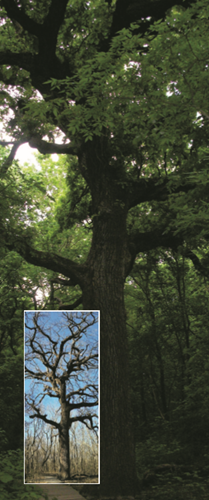

Published June 1, 2010 By KATHERINE PONDER
Collin County is fortunate to have a long history that rivals even our southern cousin, Dallas. Some of the grand trees that stood as saplings in the 1700s are still here, silent witnesses to change on the upland prairie. Despite large-scale farming and ranching on our blackland soils, giants along river bottoms and flood plains have held their own.

This bur oak tree at the Heard Natural Science Museum and Wildlife Sanctuary is estimated to be more than 250 years old. The beauty of its venerable branching may be seen even in the winter. Photo by Katherine Ponder.
Soaring Canopies in McKinney
Follow Wilson Creek and you’ll find many of McKinney’s largest and oldest trees. “The whole Wilson Creek corridor has some very large trees,” says McKinney City Arborist and Landscape Architect Emily Braht. She cites the Texas Tree Trails’ Big Tree List in noting that virtually all of the largest recorded trees in McKinney are on Wilson Creek, including several large pecan trees and a sycamore. At the Wilson Creek Nature Trail just south of Towne Lake, a 200-plus year-old bur oak testifies that this sometimes boggy area wasn’t suitable for building roads or farms – just growing big native trees. Families visiting the lake area have wandered across Wilson Creek and into this forest land for generations.
The Heard Natural Science Museum and Wildlife Sanctuary, on the city’s southeast side, also has many statuesque trees, including another venerable bur oak. This woody sentinel is estimated to be more than 250 years old and likely provided shade to Ms. Bessie Heard (1886-1988), the museum’s namesake founder and one of McKinney’s most significant benefactors.
Venture west on Highway 380 and you’ll spy the Third Monday Trade Days grounds. At the farthest end of the parking lot, look for a small grove protecting a virtually hidden cemetery. This tiny spot of pecan trees and cedar elms shade the burial site of some of Collin County’s first pioneers, the ones who settled Peters Colony headed by John McGarrah. The Texas Legislature designated the area as the official county seat in 1846 and renamed it Buckner. However, by 1848, planners discovered that Buckner was more than three miles from the county center, as required by law. Buckner became a historical asterisk and McKinney grew up as the county seat.
Keep traveling on 380 to see the new Tucker Hill development, which is a great example of maintaining significant trees even while finding new uses for land. “Tucker Hill has huge trees in the creek corridor and they are obviously very old,” says Braht. “The property was previously farmland and personally owned ranch land. The creek areas are floodplain, so they weren’t cleared. All of our big trees are related to the floodplain. It’s important to keep those areas undeveloped.” Agricultural people knew that floodplain and creek sides weren’t viable land and these ribbons of land give the city some historic, natural space.

A majestic stand of native trees can be found adjacent to Wilson Creek near Towne Lake Park. Photo by Katherine Ponder.
Elsewhere in the County
Other cities also have historic, large trees and documentation of their presence and age. Plano’s parks can make some of the biggest boasts. The National Arborist Association recognizes that a bur oak tree in Bob Woodruff Park was alive and well at the time that the U.S. Constitution was signed. Texas Tree Trails founder and president of Arborilogical Services, Steve Houser, worked with other experts to use tree-ring calculations (from a broken branch) to prove that the oak is more than 500 years old. “The city of Plano planned to have a bicentennial celebration for the oak, and we had to change it to the quincentennial celebration,” he notes, chuckling.
Haggard Park can boast of its Regional Champion Overcup Oak, as verified and designated by the Texas Tree Trails Big Tree List. This giant measures more than eight feet in circumference and 50 feet tall.
The Heritage Farmstead Museum in Plano shows trees in action, so to speak, at the original home of Ammie Wilson. “A historic tree that comes to mind is just outside the front door of the old house at Heritage Farmstead,” shares Candace Fountoulakis, of the City of Plano’s Data Collection area and a Collin County Master Gardener. “It’s a western species of juniper that they planted here long ago.” Fountoulakis also notes that in Plano’s new Oak Point Park & Preserve, you can see the remnants of the pecan hybridization program by William Prince in the 1930s and 40s.
Think you’ve got a Whopper?
There are many other historic, very old trees in the county and our city as well. However, rapid development and anonymity may be their downfall – literally. It takes volunteers to find and record our biggest and most historic trees. The Texas Forestry Service maintains a list of champion trees, certifying which ones are the biggest. “We don’t have very many record holders in Collin County,” explains Forester Justin Wise. “It’s historically prairie land and areas like East Texas that have untouched natural forest stand a better chance at record holders.”
